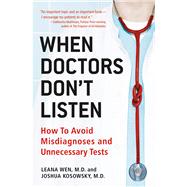
DR. LEANA WEN is a resident physician at Brigham & Women’s and Massachusetts General and clinical fellow at Harvard Medical School. A Rhodes Scholar, Wen is a past national president of the American Medical Student Association.
DR. JOSHUA KOSOWSKY is assistant professor at Harvard Medical School and the Clinical Director of the Brigham & Women’s Emergency Medicine Department. He is the author of over two dozen articles and textbook chapters, and is co-editor of Pocket Emergency Medicine.
"This is a well-written book on an innovative approach to healthcare reform: it challenges patients to take charge of their health and every medical encounter with their doctor. An important topic and an important book--I encourage my patients to read it."
—Siddhartha Mukherjee, author of The Emperor of All Maladies: A Biography of Cancer
"I have always said that a hospital can kill you as sure as cure you. You must be your own best advocate. Follow the advice of Drs. Wen and Kosowsky…and transform from being a patient to an advocate for your own health."
—Fran Drescher, actor, producer, activist, and author of Cancer Schmancer
“It’s critical for patients to advocate for their own health. This book teaches you how…Read it; it will change radically how you approach your doctors.”
—Melissa Etheridge, Academy Award- and Grammy Award-winning musician
“This clearly-written, brilliantly and creatively thought-out book, filled with fascinating and horrifying examples of how doctors are now trained to not listen to their patients in order to ‘rule out’ diseases, focuses on ‘ruling in’ diagnoses that not only are accurate, but that will save billions of dollars per year in lawsuit-driven tests. A brave, terrific, essential work.”
—Samuel Shem, M.D., Ph.D., author of The House of God and The Spirit of the Place
"Leana Wen and Josh Kosowsky have written an authoritative guide to answer a seemingly simple question: How should you talk to your doctor? Through fascinating examples taken from their own clinical experiences, they show how doctors’ training fails to teach real listening skills. But Drs. Wen and Kosowsky don't stop there: They also offer up constructive and practical advice that just might save your life."
—Darshak Sanghavi, MD, Chief of Pediatric Cardiology, University of Massachusetts Medical School, health care columnist for Slate, contributing editor at Parents magazine, and author of A Map of the Child: A Pediatrician's Tour of the Body
“Their proposal for ‘diagnostic partnership’ is a major contribution of this courageous book in which common sense plays the leading role.”
—Julio Frenk, MD, PhD, Dean of the Harvard School of Public Health
“A powerful appeal for individualized medical evaluation based on an active partnership between doctors and patients. The rational, mutual approach to diagnosis advocated by Drs. Wen and Kosowsky is the antidote for mindless and wasteful routines that all too often replace careful listening and focused assessment of each patient.”
—Harvey V. Fineberg, M.D., Ph.D., President, Institute of Medicine
“Exposes the stereotypic physician following cookbook recipes to liberating a new frontier in the ‘art’ of humanistic medicine that empowers patients and physicians alike.”
—Lincoln Chen, MD, Director, Global Equity Center at Harvard Kennedy School of Government
“Not only offers a compelling argument for revitalizing this touchstone of good medicine, but also provides a comprehensive guide for how doctors and patients can improve the quality of healthcare by doing so.”
—Jordan J. Cohen, MD, Professor of Medicine and Public Health, George Washington University, and President Emeritus, Association of American Medical Colleges
"This is an important contribution to helping both physicians and patients more effectively manage their encounters. The authors make it clear that ‘more medical care’ may frequently be harmful to a patient's health.”
—Robert Graham, MD, Professor of Family and Community Medicine, University of Cincinnati
“This book is a must read for informing the dialogue about health care reform and transforming medical education. Its humanistic authors provide support for re-integrating the lost art of humanism with more scientific medicine. The authors’ passion for the individual behind the illness is contagious.”
—Afaf I. Meleis, Ph.D., DrPS (hon), FAAN, Margaret Bond Simon Dean of Nursing, University of Pennsylvania
"Doctors take an oath to do no harm. Yet more than ever, modern medicine makes healthy people sick. Emergency physicians Leana Wen and Josh Kosowski make a passionate argument for patients to get involved and informed about their care. A fast, smart read to help you take charge of your health."
—Audrey Young Crissman, MD, author of What My Patients Taught Me: A Medical Student’s Journey
"Evidenced based medicine, clinical guidelines, and diagnostic algorithms have been widely adopted as an answer to inconsistent and out-of-date medical practice. Drs. Leana Wen and Joshua Kosowsky make the case that the resultant algorithms-gone-wild syndrome seen in many medical settings today actually drives imprecise and wasteful testing, muddled diagnoses, and patient confusion. They argue that these clinical behaviors are at the heart of our “morbidly obese” medical care system and that thoughtful physicians relying on patient narratives and diagnostic common sense will create a leaner medical care system and better patient outcomes. Theirs is a contrarian and compelling case with the wellbeing of millions of patients and $250 billion a year riding on it."
—Fitzhugh Mullan, MD, Murdock Head Professor of Medicine and Health Policy, The George Washington University
The New copy of this book will include any supplemental materials advertised. Please check the title of the book to determine if it should include any access cards, study guides, lab manuals, CDs, etc.
The Used, Rental and eBook copies of this book are not guaranteed to include any supplemental materials. Typically, only the book itself is included. This is true even if the title states it includes any access cards, study guides, lab manuals, CDs, etc.